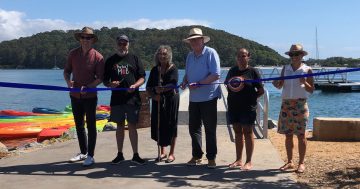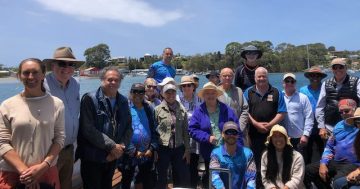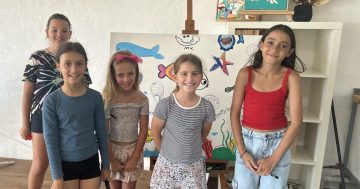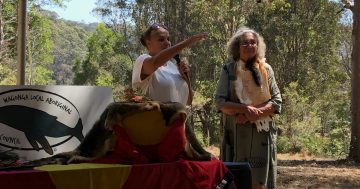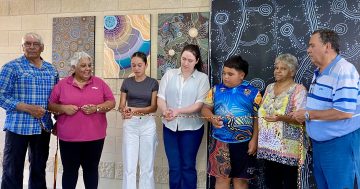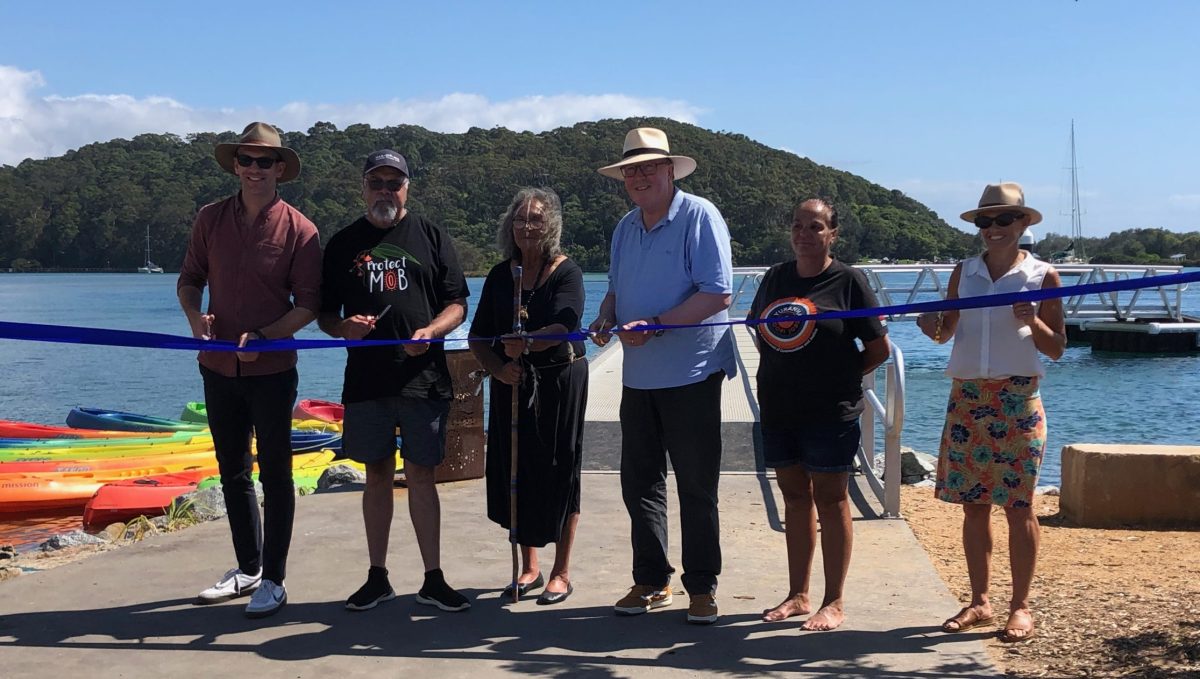
Eurobodalla Shire Mayor Mat Hatcher, Joonga Land and Water Aboriginal Corporation director Wally Stewart, Aunty Vivienne Mason of the Djaadjawan Dancers, Member for Bega Dr Michael Holland, Julie-Ann Mason, chair of Wagonga Local Aboriginal Land Council, and Tonia Clarkson of NSW Department of Primary Industries and Regional Development, cutting the ribbon at the official opening of the Wagonga Inlet Living Shoreline in Narooma on 1 February. Photo: Marion Williams.
Narooma’s award-winning Living Shoreline project on Wagonga Inlet officially opened with a free community event.
After the Welcome to Country, smoking ceremony and speeches by government representatives, there was a performance by the Djaaedjawan Dancers about a tragedy that happened to Narooma’s First Nations people in the 1800s.
There were also free tours on the land, and tours on the water in glass-bottomed kayaks, courtesy of Region X from Batemans Bay. Narooma’s Jakob Poyner who appeared in Australian Idol 2023, provided live music.
The Living Shoreline project was a collaboration between three levels of government, Aboriginal organisations, government and citizen scientists, oyster farmers, local Aboriginal artists Nigel Stewart and Natalie Bateman, and volunteers over several years.
It has transformed a stretch of the shoreline that was marred by a failing rock wall into an attractive area with diverse plantings that help provide protection from erosion.
The rock wall was replaced with banks of low-growing riparian vegetation to create an environmentally friendly seawall.
The new jetty and floating pontoon near the ‘Deep Hole’ has become a popular swimming spot and there are educational signs incorporating Aboriginal artwork along the foreshore walk.
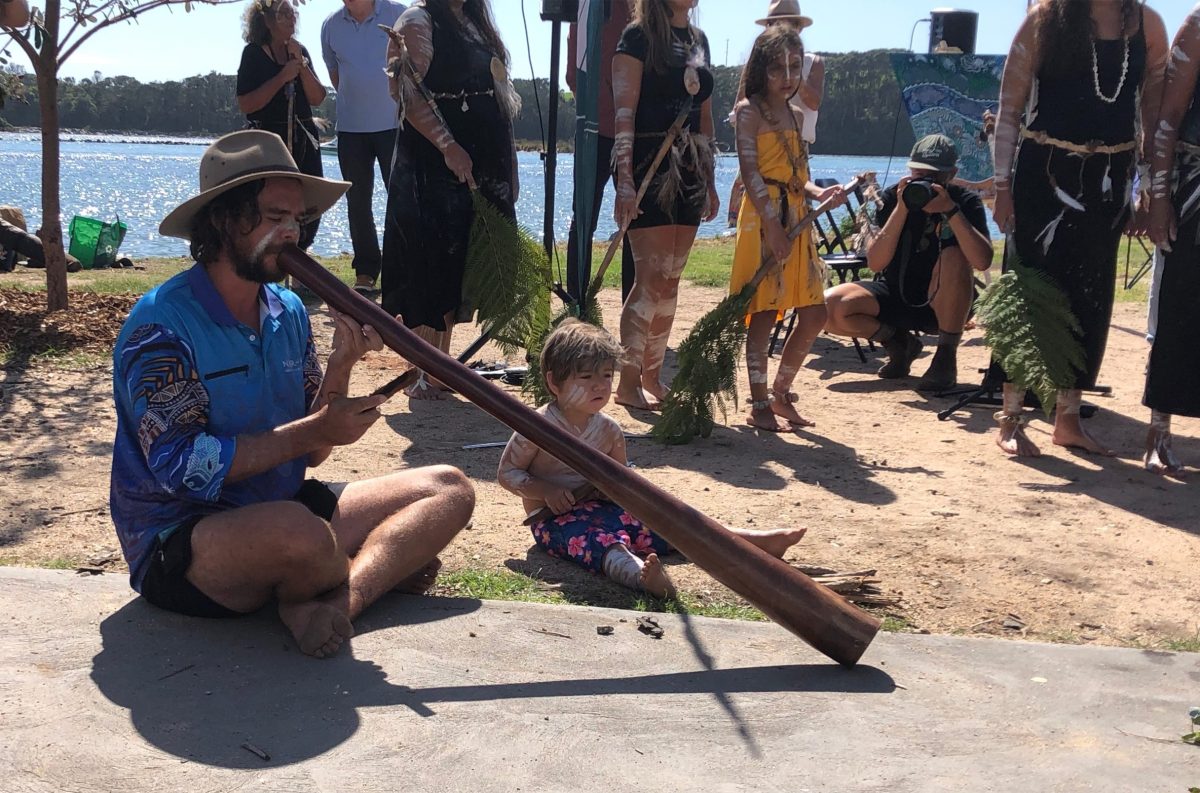
Brock Tutt playing the didgeridoo and his son Binnin-gala Tutt playing the clapsticks during the smoking ceremony. Photo: Marion Williams.
Environmentally significant work has been carried out underneath the water, with the creation of intertidal Sydney Rock oyster reef habitat in the shallower waters and subtidal Native Flat oyster reef habitat on the sea floor of the Deep Hole.
James Caffery, vice president of Nature Coast Marine Group Eurobodalla (NCMG), said where there were previously no oysters, there were 3,000,000, and where there were no species of fish, there were now around 20, similar to the number of species that other oyster reefs supported.
“When you are in the water, instead of seeing crumbling rock, you see beautiful plants. Some will flower and fruit, bringing in birds,” he said.
The project won the 2023 NSW Coastal Management Award for innovation. Mr Caffery said they had received many queries from across Australia, as well as from overseas.
Member for Bega Dr Michael Holland said 90 per cent of the coast’s oyster reefs had been lost since 1788. Oyster reefs provide natural filtration, natural erosion control, and natural habitat for a lot of species.
Tonia Clarkson, acting director, Marine Estate Management, NSW Department of Primary Industries and Regional Development, said vast reefs of oysters were once a vibrant part of the coastline and they also had cultural significance.
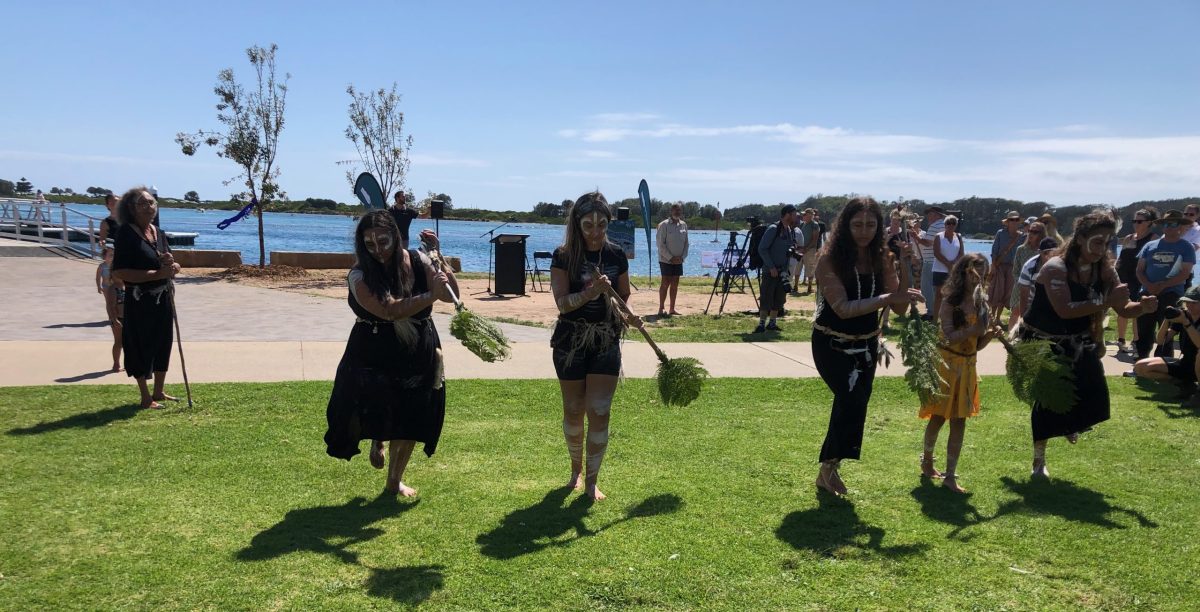
The Djaadjawan Dancers performing their dance Baranguba which tells the story of a tragedy in the 19th century. Photo: Marion Williams.
“The rich story of oysters is central to this project,” Ms Clarkson told the large crowd on Saturday, 1 February. “We are trying to restore what has been lost, which also has cultural, economic and social value.”
Ms Clarkson said it was the first time Sydney Rock oysters and the native flat Angasi oysters had been combined in the one location in NSW. She thanked Eurobodalla Shire Council staff Heidi Thompson and James Caffery for their hard work, support and unwavering enthusiasm.
“Many other councils have been inspired by this project,” she said. “So many people have worked on it.”
In April 2023, the Nature Conservancy and Joonga Land and Water Aboriginal Corporation (Joonga) divers dropped bags of rare baby Angasi oysters onto the reefs and spread them out across six rocky reefs. Another Angasi oyster seeding event happened a year later. The Sydney Rock oysters colonised the reefs naturally.
During 2023 and 2024 volunteers from Nature Coast Marine Group and OzFish surveyed the reefs to monitor the oysters’ progress.
Joonga rangers planted 16 different salt marsh and terrestrial species, some 13,000 plants, while Landcare community plantings added to the native salt marsh and coastal plants along the banks.
In his Welcome to Country, traditional owner Wally Stewart said Wagonga Inlet was one of the healthiest waterways on the east coast.
“Our message is if you have healthy country, you have healthy people,” Mr Stewart said.
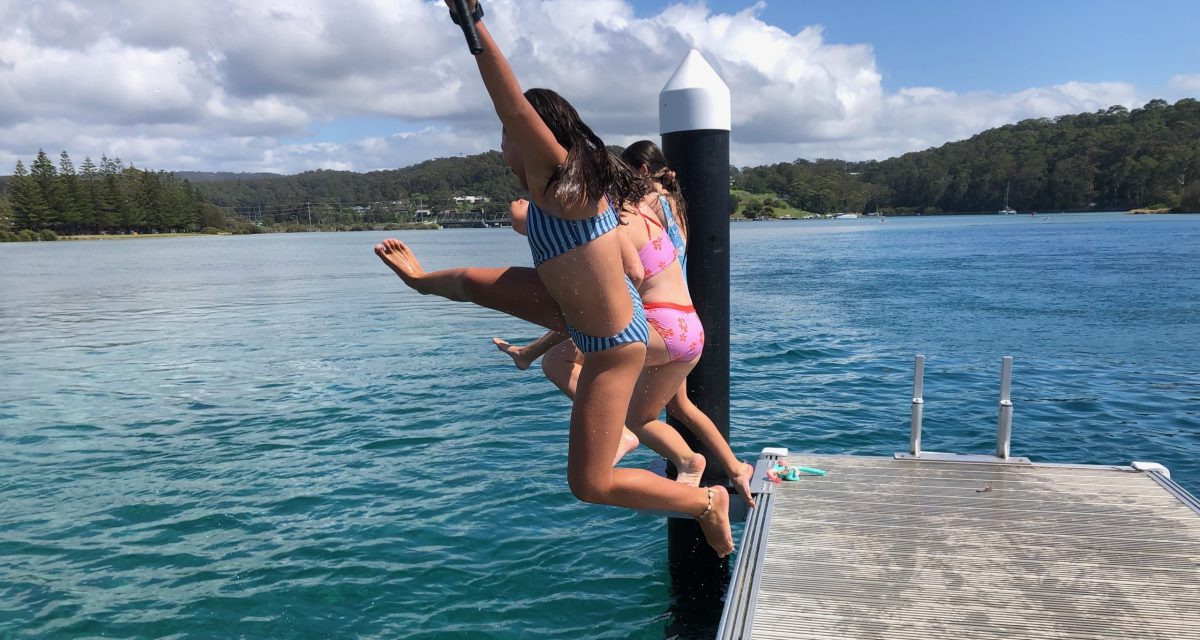
The first three to dive off the new jetty at the official opening of the Wagonga Inlet Living Shoreline. Photo: Marion Williams.
Brock Tutt performed the smoking ceremony and played the didgeridoo while people queued to take in the cleansing smoke.
“It is healing for us,” Mr Tutt said. “It heals our mind, body and spirit, and wards off negative energies.”
Eurobodalla Shire Mayor Mat Hatcher said it was a truly remarkable project and he was proud of everyone coming together.
Mr Caffery said the living shoreline was not just for people’s recreation, but also provided habitat and resilience to climate change.
The Living Shoreline project was funded through the NSW Department of Primary Industries’ Marine Estate Management Strategy, the Nature Conservancy Australia and the Australian Government through its Reef Builder initiative, and Eurobodalla Shire Council managed funding from the NSW Environment Trust and the NSW Recreational Fishing and Camping Facilities program.







